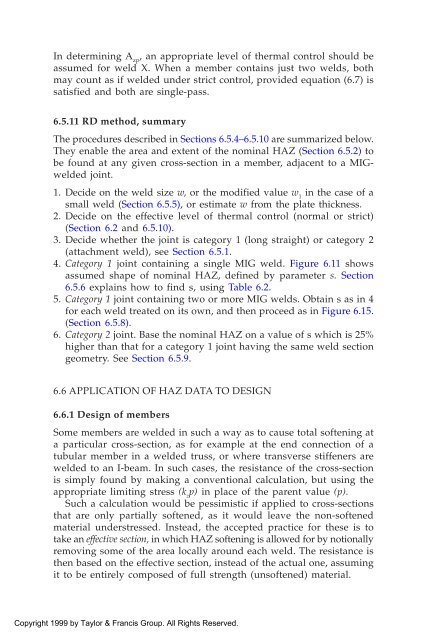Aluminium Design and Construction John Dwight
Aluminium Design and Construction John Dwight
Aluminium Design and Construction John Dwight
Create successful ePaper yourself
Turn your PDF publications into a flip-book with our unique Google optimized e-Paper software.
In determining A zp , an appropriate level of thermal control should be<br />
assumed for weld X. When a member contains just two welds, both<br />
may count as if welded under strict control, provided equation (6.7) is<br />
satisfied <strong>and</strong> both are single-pass.<br />
6.5.11 RD method, summary<br />
The procedures described in Sections 6.5.4–6.5.10 are summarized below.<br />
They enable the area <strong>and</strong> extent of the nominal HAZ (Section 6.5.2) to<br />
be found at any given cross-section in a member, adjacent to a MIGwelded<br />
joint.<br />
1. Decide on the weld size w, or the modified value w1 in the case of a<br />
small weld (Section 6.5.5), or estimate w from the plate thickness.<br />
2. Decide on the effective level of thermal control (normal or strict)<br />
(Section 6.2 <strong>and</strong> 6.5.10).<br />
3. Decide whether the joint is category 1 (long straight) or category 2<br />
(attachment weld), see Section 6.5.1.<br />
4. Category 1 joint containing a single MIG weld. Figure 6.11 shows<br />
assumed shape of nominal HAZ, defined by parameter s. Section<br />
6.5.6 explains how to find s, using Table 6.2.<br />
5. Category 1 joint containing two or more MIG welds. Obtain s as in 4<br />
for each weld treated on its own, <strong>and</strong> then proceed as in Figure 6.15.<br />
(Section 6.5.8).<br />
6. Category 2 joint. Base the nominal HAZ on a value of s which is 25%<br />
higher than that for a category 1 joint having the same weld section<br />
geometry. See Section 6.5.9.<br />
6.6 APPLICATION OF HAZ DATA TO DESIGN<br />
6.6.1 <strong>Design</strong> of members<br />
Some members are welded in such a way as to cause total softening at<br />
a particular cross-section, as for example at the end connection of a<br />
tubular member in a welded truss, or where transverse stiffeners are<br />
welded to an I-beam. In such cases, the resistance of the cross-section<br />
is simply found by making a conventional calculation, but using the<br />
appropriate limiting stress (kzp) in place of the parent value (p).<br />
Such a calculation would be pessimistic if applied to cross-sections<br />
that are only partially softened, as it would leave the non-softened<br />
material understressed. Instead, the accepted practice for these is to<br />
take an effective section, in which HAZ softening is allowed for by notionally<br />
removing some of the area locally around each weld. The resistance is<br />
then based on the effective section, instead of the actual one, assuming<br />
it to be entirely composed of full strength (unsoftened) material.<br />
Copyright 1999 by Taylor & Francis Group. All Rights Reserved.















